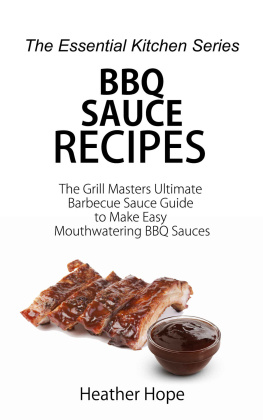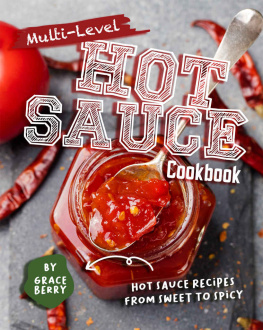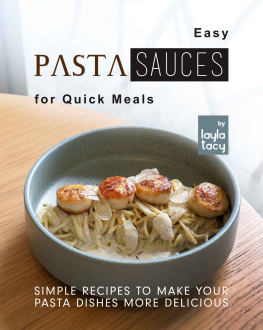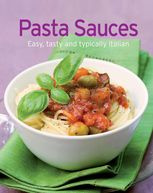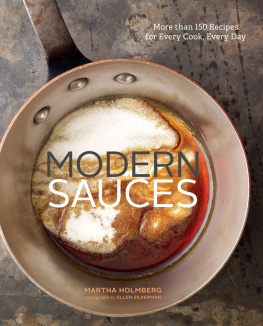A Cookbook to Jazz Up Your Meals & Add the 'Wow Factor'
By Kyle Richards Table of Contents Copyright Kyle Richards 2014 All Rights Reserved. No part of this book may be reproduced without our express consent. A good sauce can make a meal. Think of a rich, creamy cheese bchamel poured over tender cauliflower florets, a sweet, aromatic tomato and basil sauce tossed with fresh pasta, or a light, vanilla-scented custard drizzled around a slice of apple pie - simple marriages made in heaven. Sauce is a French word, originally taken from the Latin salsus , meaning salted. Classically, a sauce is a flavorful liquid that has been thickened in one of several standard ways and is used to accompany or coat a food.
Nowadays, the definition has expanded to include not just classic French-style sauces but salsas, relishes, chutneys, and dressings too. All these add flavor, color, texture, and moisture to food, and can even make it easier to digest. The key to success with sauces is to ensure that they complement and enhance the food they are to be served with. They should never overpower a dish, but should have a clean, well-defined flavor and a pleasing texture and consistency. Although sauces are strongly associated with French cooking, they are an essential element in every cuisine. Now that global travel is available to all, we are more curious about the food of other cultures; at the same time, our supermarkets stock a massive range of ingredients from all over the world.
As a result, the scope for experimenting with sauces has increased enormously. Its a shame that so many home cooks reach for a store-bought sauce rather than making their own. Commercial sauces are often laden with thickeners, colorings, preservatives, and other additives. Making fresh sauces at home will enhance your cooking beyond recognition. And although some require a degree of skill and judgment, others can be as simple as whizzing a few ingredients in a blender to make a pesto or relish. Creating great sauces is within the reach of any home cook.
Many sauces can easily be put together in the time it takes for the rest of the meal to cook, and a surprising number of them require no cooking at all. Some, especially the French classics, take rather longer and may require a good stock base. If you dont have the time or the inclination to make your own stock, simply buy the best ready-made stock you can (the fresh ones in cartons are usually good, but check the ingredients; they should all be ones you would use at home). Sauces make a fantastic shortcut to different cultures and cuisines. You can take a very simple dish, cut of meat or vegetables and turn it into a gourmet experience, just by adding an amazing sauce. Sauces can also be used as a 'dipping sauce' that can entice children to eat many foods perhaps they wouldn't otherwise eat, simply by offering a sauce to dip their food into, especially picky toddlers.
In the days before refrigeration, sauces were often used to mask foods that were thought to be tainted in flavor. The Romans were the first to disguise dubious freshness in this way; they also used saucing as an opportunity to demonstrate the variety of costly spices the host had available. This practice continued well into the Middle Ages. Looking through old recipes in some collection of cookery books, you can see that sauces were often so heavily spiced and seasoned that it must have been almost impossible to single out any particular flavor, never mind taste the food underneath. It was the French who developed the kind of sauces we are familiar with in the West today. In the beginning of the nineteenth century, Antonin Careme devised the first classification of sauces, based on five standard preparations, which he christened mother sauces.
These are espagnole (a brown, stock-based sauce thickened with flour and butter), demi-glace (a mixture of espagnole and brown stock that is reduced and nowadays usually thickened by simmering), bchamel (a milk-based white sauce thickened with flour and butter), veloute (a white sauce made with stock rather than milk), and tomato sauce. These five form the base from which all French sauces are derived. They are rarely served in their basic forms; instead, various ingredients and flavorings are added to make a particular sauce, transforming the original in minutes. The variations are known as daughter sauces for obvious reasons. Over time, the classic French repertoire was expanded by the addition of other sauces introduced from abroad. There is also a separate, smaller category of cold sauces, which are mostly derived from mayonnaise or vinaigrette.
The majority of classic sauces are thickened with starch, usually flour. However, during the nouvelle cuisine era of the 1970s, a small group of prominent chefs decided to eliminate starch as much as possible in order to produce lighter sauces. The heavy, flour-thickened brown sauces were replaced by ones thickened with arrowroot or simply by boiling so that they reduced and thickened naturally. Butter sauces such as beurre blanc were suddenly fashionable, while velouts became much lighter. This revolutionized sauce-making, and the more time-consuming sauces have never really come back into fashion. For the home cook, this is definitely good news.
So, too, is the revolution brought about by modern equipment. Blenders and food processors enable anyone to achieve a smooth, shiny, and perfectly blended sauce. They have also coincided with the fashion for simple, colorful vegetable and herb purees that can be whizzed up in minutes and served as attractive and wholesome accompaniments to fish and other meat. French culinary traditions die hard, but today, sauce-making is a much less structured affair than it used to be. Chefs can pick and choose from a variety of culinary traditions, and it is common to see a juxtaposition of styles and influences on restaurant menus. This, in turn, influences what we choose to eat at home, and sauce-making for the domestic cook has never been simpler or more accessible.
Sauces are an essential part of good cookery. Chosen with understanding, they lend interest and distinction. They complement, enhance, and impart a certain elegance to the very best of food. As the art of making sauces has developed, more and more kinds of sauces have been created. The French, particularly, have mastered this branch of cookery to a notable degree. It is in large measure due to their efforts that todays world has its heritage of fine sauces.
There are, of course, exceptions. There are some great German sauces, for instance, and others from Italy and Spain. The assorted tomato sauces, dissimilar as they are, had their beginnings in separate regions: in Italy, in France, or in Mexico. Fruit sauces are usually Teutonic or Scandinavian in origin. The various kinds of sauces, when arranged in a logical pattern, are not unlike a family tree. There are a few foundation or "mother" sauces from which derive a whole series of related types that are created by the addition of wine, herbs, seasonings, or piquant ingredients of sundry kinds.
White sauce and brown sauce are two examples of this "mother" group. Both sauces are thickened by roux (equal parts of fat and flour, heated together). For white sauce, the pale, delicately flavored stock from veal, chicken, or fish is used. However, either milk or a combination of milk and stock serves as the liquid in some recipes. In the preparation of these sauces, the color of the roux remains white throughout the heating step. The brown sauces have a robust brown stock as their base, and the roux is browned to the degree that the flour is allowed to "roast" during heating.
Other foundation sauces include the butter sauces (which are essentially seasoned butter) and the mayonnaises, which are made from egg yolk and oil or butter. (With oil, these sauces are known as mayonnaise; with butter, hollandaise.) Beyond these, there is a large group of assorted sauces that may be classified in different ways. Some authorities lump them together and call them cold and hot "special sauces." Others separate then into 2 groups: (1) barbecue sauces, comprised of various sauces that are heavily seasoned, usually with vinegar; and (2) miscellaneous sauces, including the tomato and fruit sauces. In the French domain, sauce-making has always been regarded as a worthy art and treated as a serious matter. According to tradition, expert preparation requires knowledge, practiced skill, and a long, painstaking procedure. In our country, conditions are somewhat different; different thoughts prevail.








